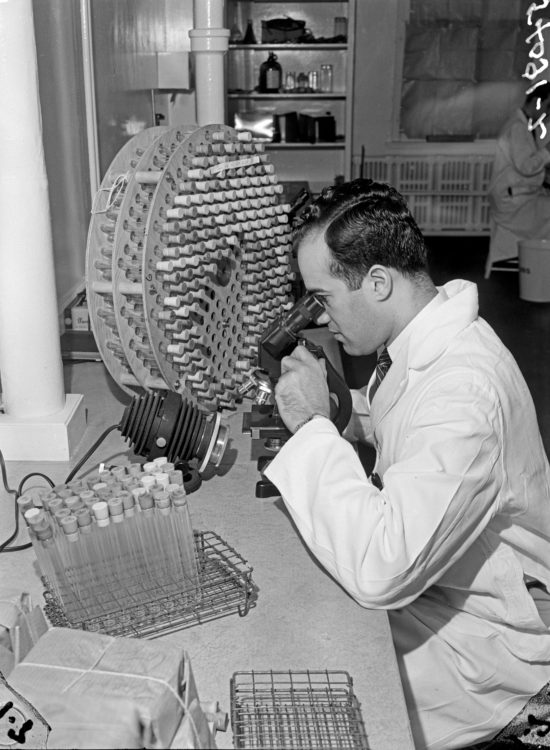
There has been considerable controversy about the rollout of vaccines. In some nations and the European Union, this has led to the sequestering of vaccines produced within their jurisdictions. Countries like Canada, without domestic vaccine production capacity, inevitably face slower rollouts. In fact, as of March 2021, Canada is one of the poorest performers among high-income countries in its vaccination rollout, as the lack of secure supply early in 2021 triggered hesitancy among numerous provincial and territorial governments. The truth is that we no longer have the university-based research, development and manufacturing base we need to discover and produce these needed vaccines.
Sadly, Canada once had such capacity – Connaught Laboratories at the University of Toronto’s School of Hygiene was one of the world’s premier vaccine companies until it was privatized in the 1980s. In the last great pandemic a century ago, Connaught not only produced all of our domestic supply of vaccines, it exported vaccines to the United States and the United Kingdom. However, the trend toward neoliberalism and cost-cutting in universities that began in the 1970s and culminated in the privatization of non-profit enterprises such as Connaught in the 1980s means that Canada is now reliant on foreign markets for what it used to produce itself.
The pandemic has made many countries realize that the production of vaccines constitutes a strategic national asset. The Council on Foreign Relations, in a special COVID report, has said that there is a need to recognize the threat that infectious diseases pose and that the United States should “make pandemic preparedness a national security priority on par with national defense, and organize and invest accordingly.”
The story of how we once had this capacity may be known but the “secret sauce” that made this university-based, non-profit vaccine manufacturer a major success is not as well understood. The ingredients to Connaught’s achievement are highly salient to today’s pandemic and provide some important policy lessons on how we might create vaccine capacity domestically to prepare for the future.
Connaught Laboratories
Established in 1917 by Dr. J.G. FitzGerald of the University of Toronto’s School of Hygiene, Connaught Laboratories was a pharmaceutical enterprise specializing in research and the production (and sale) of vaccines and insulin. FitzGerald was motivated by the fact that Canada was the only country of its size in the world at the time without such a facility.
In contrast to the private pharmaceutical manufacturers, Connaught emphasized basic research, combining the bench strength of research scientists along with a deep desire to address public health issues including infectious epidemics. Connaught also benefited from the school’s solid contacts with provincial public health agencies across Canada. The labs’ subsequent success demonstrated the power of linking research and education to public service.
Connaught provided vaccines and insulin to the public at cost and worked closely with local, provincial and national public health agencies. When required, the labs exported vaccines to other countries at a cost well below the prices charged by private pharmaceutical companies. Connaught and the school were doing major research and development long before research and development (R&D) existed as a corporate catchphrase. In its heyday, Connaught made Canada almost completely self-sufficient for its domestic vaccine needs.
Connaught’s key advantage was that it was based in a university, specifically in a school of public health. This made it very aware of, and responsive to, public health needs in Canada and beyond, driving the labs’ research agenda. For most of its history the director of the School of Hygiene was the director of Connaught. Making its products available was paramount, and Connaught sold vaccines as close as possible to cost while constantly working to drive down its own cost of production. Connaught worked closely with the provincial governments enabling them to make vaccines accessible to their residents.

Connaught became an important national resource, playing a pivotal role in combatting every major infectious disease and meeting every major health-care need from 1917 onward, including the infections contracted in the trenches of the First World War, the diphtheria epidemics of the 1910s and 1920s (making Toronto and Hamilton the first cities in the world to be diphtheria-free), heparin in the 1930s, tetanus and typhus in the Second World War, and polio in the 1950s. Such was its contribution to the polio epidemic that its director was given the prestigious Lasker Award in 1955, one of only three Canadians to ever receive this international award in the last 75 years. In the 1960s, Connaught was so trusted as a producer of high-quality and low-cost vaccines that it was called upon by the World Health Organization (WHO) to help it launch its global effort to eliminate smallpox and improve standards for vaccine productions throughout the Americas.
In its specialty areas, Connaught grew into one of the world’s largest and most reputable pharmaceutical and vaccine-making manufacturing facilities. It was also self-sustaining. Not drawing on the resources of the university or taxpayers, it actually contributed research funds to scientists engaged in vaccine research at the university. Connaught had a mandate that could be compared to equivalent research arm of the Center for Disease Control (CDC) in the United States or the Lister, Pasteur and Koch institutes in Britain, France and Germany. However, Connaught went a step further by producing vaccine, insulin and pharmaceuticals.
As a focal point for public health response to infectious disease, Connaught was instrumental in the establishment of the Dominion Council of Health, which brought together the federal and provincial deputy ministers of health plus the School of Hygiene director. A majority of the deputy ministers of health in Canada were grads of the school.
Sale and privatization of Connaught
In 1972, the University of Toronto sold Connaught Laboratories to a federal Crown corporation, the Canada Development Corporation (CDC). The chair of the University of Toronto’s Connaught Committee recommended that the university divest itself of Connaught. Despite its success, then-university president John Evans saw that Connaught required significant investment to update its facilities. He decided that it was not the role of the university to provide the funding. Evans’s judgment at the time should have been vigorously debated given the fact that Connaught had dramatically scaled-up in each of the two world wars out of its own or government resources. However, his decision was accepted with little argument by the university board.
Mandated to develop and maintain Canadian-controlled companies in the private sector, this sale brought in private investment and an increase in the price of the labs’ products, triggering allegations of mismanagement and deteriorating product quality. By 1986, the federal government’s ownership of Connaught had been completely sold to the private sector as the CDC was dismantled, part of the Mulroney government’s program of privatization.
The sale and privatization of Connaught was a strategic error. Why did it even happen? Connaught’s penchant for always driving prices down did not endear it to the major pharma companies. With the sale, the Canadian government lost an important capability. In Connaught’s history the Canadian government had called upon it to provide assistance in urgent situations of national health. Canada lost a world-class vaccine-making facility and the research expertise and critical mass that came with it.
Connaught invested a much higher proportion of its revenues in R&D than private firms did. During much of this time this research funding was particularly important as this was before the establishment of government-funded research councils such as the Medical Research Council (a precursor to the Canadian Institutes of Health Research).
The university’s School of Hygiene lost an important revenue source that it could use to support basic research on vaccines, including the support Connaught provided to the work by Frederick Banting and Charles Best on insulin in the 1920s. And the country lost a critical mass of research capacity in both basic and applied vaccines research.
We now face a situation in which the countries of the European Union and the United States have taken steps to protect their domestic supply of vaccines and prevent companies from exporting to nations such as Canada without a domestic supply.
The Trudeau government’s NRC-Novavax initiative and what should be done instead
The COVID-19 pandemic has made the Trudeau government realize the extreme vulnerability of not having a domestic vaccine production capacity. The country is has recently woken up to our deficiency. However, its solution – pumping a huge amount of public money into a National Research Council-owned facility to produce tens of millions COVID-19 doses produced by U.S.-based Novavax – is poor public policy.
It would be far better to place this enormous investment into a non-profit, university-based enterprise that has the essential elements for success. Investing in basic research combined with production and a public health mandate of providing as much vaccine as possible at the cost of production makes sense. Strong arguments can be made that the curiosity-driven research coming out of the public universities, not just in Canada, is what really fuels the pipeline for new therapeutics. Rockefeller University (26 Nobel Prizes, 24 Lasker Awards) is the outstanding example and interestingly it had its origins in infectious diseases just as Connaught and the School of Hygiene.
In effect, this would be an investment in a public health ecosystem, something that is missing in Canada today. The scientists involved in such a venture would be part of a rich research network involving a school of public health, a faculty of medicine, hospital-based research institutes and academic health sciences centres along with their international research collaborations and networks. No private pharmaceutical company can replicate such an ecosystem.
A successful vaccine production capacity also requires a basic research and curiosity-driven pipeline. At the same time, as demonstrated by Connaught, a university-based enterprise can also deliver the applied research, including the clinical base of the university-affiliated health sciences centres for clinical trials as well as the tech-transfer and commercialization components.
So, how might this be done? Using the Canadian Foundation for Innovation or some other vehicle, proposals should be solicited immediately from Canadian universities and their partners for a national facility. Submissions need to come from research-intensive universities that have both faculties of public health and medicine. Proximity to a research park with biomedical activities would be an asset.
Looking ahead
The potential of such a non-profit, university-based initiative represents more than just vaccines. Specifically, in a future pandemic event a portion of the laboratory space of a vaccine lab, along with academic lab space, could be temporarily used to process surveillance tests. This is what happened with the Francis Crick Institute in London. Its director, Sir Paul Nurse, noted how one of its labs had been transformed into high-throughput testing lab.
The laboratory facilities of a Canadian facility could also be used for fundamental research into the basic biology of any threatening virus. Were we to re-establish such capability within this we would be deploying the best brains that could be used as part of any pan-Canadian pandemic preparedness strategy.
The time has come for this country to up its game. We were warned. The 2003 Naylor report, Learning from SARS, warned of “emerging infectious diseases… increasing in incidence or geographic range.” We should have taken note then, but the COVID-19 pandemic drives the point home that we need to ensure the critical research and production capacity that will ensure the future production of vaccines in this country.











